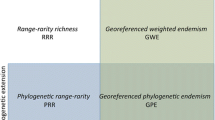Abstract
The maximal covering species problem (MCSP) is becoming an accepted method for selecting networks of reserves for the preservation of species and their habitats. Drawing on experience with the MC location P (MCLP), we expect that the objective function in the region of the optimum is quite flat. This implies many equal-optimal and near-optimal solutions for any particular problem. We propose a new type of heuristic for the MCSP: an interchange heuristic which frequently provides a better solution than greedy adding heuristics now commonly used. The proposed interchange heuristic, with multiple random starts, gives one a range of alternative sets of sites rather than a single mathematically selected solution, from which a final satisfactory solution can be chosen.
Similar content being viewed by others
References
J.D. Camm, S. Polasky, A.R. Solow and B. Csuti, A note on optimal algorithms for reserve site selection, Biological Conservation 78 (1996) 353–355.
R.L. Church, Synthesis of a Class of Public Facilities Location Models, unpublished Ph.D. thesis (The Johns Hopkins University, Baltimore, 1974).
R.L. Church and C.S. ReVelle, The maximum covering location problem, Papers in Regional Science 32 (1974) 101–118.
R.L. Church, D.M. Stoms and F.W. Davis, Reserve selection as a maximal covering location problem, Biological Conservation 76 (1996) 105–112.
K.D. Cocks and I.A. Baird, Using mathematical programming to address the multiple reserve selection problem: an example from the Eyre Peninsula, South Australia, Biological Conservation 49 (1989) 113–130.
G. Cornuejols, M.L. Fisher and G.L. Nemhauser, Location of bank accounts to optimize float: an analytic study of exact and approximate algorithms, Management Science 23 (1977) 789–810.
B. Csuti, S. Polasky, P.H. Williams, R.L. Pressey, J.D. Camm, M. Kershaw, A.R. Kiester, B. Downs, R. Hamilton, M. Huso and K. Sahr, A comparison of reserve selection algorithms using data on terrestrial vertebrates in Oregon, Biological Conservation 80 (1997) 83–97.
L. Masters, N. Clupper, E. Gaines, C. Bogert, R. Solomon and M. Ormes, Biodiversity Research Consortium Species Database Manual (The Nature Conservancy, Boston, MA, 1995).
Microsoft, Microsoft Fortran (Microsoft Corporation, Redmond, WA, 1993).
R.F. Noss and B. Csuti, Habitat fragmentation, in: Principles of Conservation Biology, eds. G.K. Meffe and C.R. Carrol (Sinauer Ass., Sunderland, MA, 1994) pp. 237–264.
S. Polasky, J.D. Camm, A.R. Solow, B. Csuti, D. White and R. Ding, Choosing reserve networks with incomplete species information, Biological Conservation 94 (2000) 1–10.
H. Possingham, J. Day, M. Goldfinch and F. Salborn, The mathematics of designing a network of protected areas for conservation, in: Decisions Sciences: Tools for Today, Proceedings of the 12th Australian Operations Research Conference, eds. D. Sutton, E. Cousins and C. Pierce (ASOR, Adelaide, 1993).
R.L. Pressey, C.J. Humphries, C.R. Margules, R.I. Vane-Wright and P.H. Williams, Beyond opportunism: key principles for systematic reserve selection, Trends in Ecology and Evolution 8(4) (1993) 124–128.
R.L. Pressey, H.P. Possingham and C.R. Margules, Optimality in reserve selection algorithms: when does it matter and how much?, Biological Conservation 76 (1996) 259–267.
R.L. Pressey, H.P. Possingham and J.R. Day, Effectiveness of alternative heuristic algorithms for identifying indicative minimum requirements for conservation reserves, Biological Conservation 80 (1997) 207–219.
C.S. ReVelle and K.E. Rosing, Defenders imperium romanum: a classical problem in military strategy, American Mathematical Monthly 107 (2000) 585–594.
K.E. Rosing, C.S. ReVelle and H. Rosing-Vogelaar, Fractions in the location set covering problem, Environment and Planning B 19 (1992) 125–130.
K.E. Rosing and C.S. ReVelle, Integers in the location set covering problem, Environment and Planning B 20 (1993) 481–482.
D.A. Schilling, C.S. ReVelle, C. Cohon and D.J. Elzinga, Some models for fire protection location decisions, European Journal of Operational Research 5 (1980) 1–7.
D.A. Schilling, K.E. Rosing and C.S. ReVelle, Network distance characteristics that affect computational effort in p-median location problems, European Journal of Operational Research 127 (2000) 525–536.
S.A. Snyder, L.E. Tyrrell and R.G. Haight, An optimization approach to selecting research natural areas in national forests, Forest Science 45(3) (1999) 458–469.
L.G. Underhill, Optimal and suboptimal reserve selection algorithms, Biological Conservation 70 (1994) 85–87.
R.A. Whitaker, A fast algorithm for the greedy interchange for largescale clustering and median problems, INFOR 21 (1983) 95–108.
B.A. Wilcox and D.D. Murphy, Conservation strategies: the effect of fragmentation on extinction, American Naturalist 125 (1985) 879–887.
Author information
Authors and Affiliations
Rights and permissions
About this article
Cite this article
Rosing, K., ReVelle, C. & Williams, J. Maximizing Species Representation under Limited Resources: A New and Efficient Heuristic. Environmental Modeling & Assessment 7, 91–98 (2002). https://doi.org/10.1023/A:1015645615202
Issue Date:
DOI: https://doi.org/10.1023/A:1015645615202




